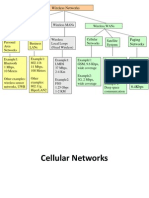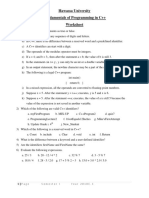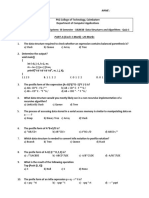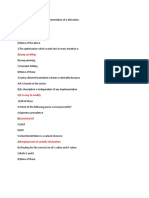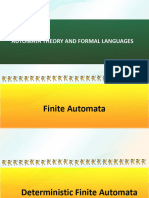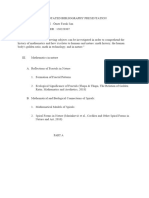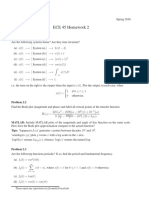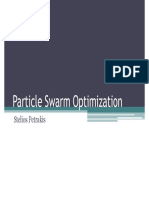Professional Documents
Culture Documents
Mr. Dereje B (MSC) : Automata and Complexity Theory
Mr. Dereje B (MSC) : Automata and Complexity Theory
Uploaded by
mesfin teshome100%(1)100% found this document useful (1 vote)
460 views35 pagesThis document provides an introduction to automata and complexity theory. It discusses that theory of computation deals with how efficiently problems can be solved using algorithms and mathematical models of computation. The theory of computation is divided into three fields: automata theory and formal languages, computability theory, and complexity theory. Automata theory studies mathematical models of computation like finite automata, context-free grammars, and Turing machines. It also defines key concepts like alphabets, strings, languages, and different types of automata like finite automata, deterministic finite automata, and non-deterministic finite automata.
Original Description:
Original Title
Untitled
Copyright
© © All Rights Reserved
Available Formats
PPTX, PDF, TXT or read online from Scribd
Share this document
Did you find this document useful?
Is this content inappropriate?
Report this DocumentThis document provides an introduction to automata and complexity theory. It discusses that theory of computation deals with how efficiently problems can be solved using algorithms and mathematical models of computation. The theory of computation is divided into three fields: automata theory and formal languages, computability theory, and complexity theory. Automata theory studies mathematical models of computation like finite automata, context-free grammars, and Turing machines. It also defines key concepts like alphabets, strings, languages, and different types of automata like finite automata, deterministic finite automata, and non-deterministic finite automata.
Copyright:
© All Rights Reserved
Available Formats
Download as PPTX, PDF, TXT or read online from Scribd
Download as pptx, pdf, or txt
100%(1)100% found this document useful (1 vote)
460 views35 pagesMr. Dereje B (MSC) : Automata and Complexity Theory
Mr. Dereje B (MSC) : Automata and Complexity Theory
Uploaded by
mesfin teshomeThis document provides an introduction to automata and complexity theory. It discusses that theory of computation deals with how efficiently problems can be solved using algorithms and mathematical models of computation. The theory of computation is divided into three fields: automata theory and formal languages, computability theory, and complexity theory. Automata theory studies mathematical models of computation like finite automata, context-free grammars, and Turing machines. It also defines key concepts like alphabets, strings, languages, and different types of automata like finite automata, deterministic finite automata, and non-deterministic finite automata.
Copyright:
© All Rights Reserved
Available Formats
Download as PPTX, PDF, TXT or read online from Scribd
Download as pptx, pdf, or txt
You are on page 1of 35
Automata and Complexity Theory
Introduction
Mr. Dereje B (Msc)
4/23/23 Automata and Complexity Theory -1-
Theory of Computation
It is a branch of computer science that deals with how efficiently a
problem can be solved on a model of computation, using an algorithm.
• Theory of computation is divided into 3 fields:
1. Automata Theory and Formal Languages
2. Computability Theory
3. Complexity Theory
• The goal is to ascertain the power and limits of computation.
• In order to study these aspects, it is necessary to define precisely what
constitutes a model of computation as well as what constitutes a
computational problem.
• This is the purpose of automata theory.
• The computational models are automata, while the computational
problems are formulated as formal languages.
4/23/23 Automata and Complexity Theory -2-
cont…
1. Automata Theory and Formal Languages
• It deals with the definition and properties of various
mathematical model of computation. • Examples:
i. Finite Automata(FA)
ii. Context Free Grammar (CFG)
iii. Turing Machine (TM)
2. Computability Theory
• It deals with what can/cannot be computed by the model.
3. Complexity Theory
• It groups the computable problems based on their hardness.
Main purpose of Theory of Computation
• Develop formal mathematical model of computation that
reflect real world computers.
4/23/23 Automata and Complexity Theory -3-
Alphabets and Strings
1. Symbol
• Symbol(often also called character) is the smallest building
block, which can be any alphabet, letter, or picture.
• Example
• a, b, c, …, z
• 0,1,…, 9
• +,*, #, … special characters
2. Alphabet
• An alphabet is a finite, non-empty set of symbols.
• It is denoted by ∑.
• Examples: ∑ = {0,1} set of binary alphabets.
4/23/23 Automata and Complexity Theory -4-
cont…
Examples: ∑ = {a, b, c, …, z} set of all lowercase letters.
∑ = {A, B, C, …Z} is an alphabet of uppercase letters.
∑ = {+, #, &,$, …} set of all special characters
3. String or Word
• It is a finite collection of symbols from the alphabet.
• The string is denoted by w.
• Example: w = 01110 is string from binary alphabet ∑ =
{0,1}
w = aabbaacaa is string from alphabet ∑ = {a, b, c}
Symbol Alphabet String/Word
4/23/23 Automata and Complexity Theory -5-
cont…
4. Empty String
• Empty string is a string with zero occurrences of symbol(no
symbol)..
• It is denoted by ' ε ' → no symbol { }
5. Length of String
• It is the number of symbols in the string.
• It is denoted by |w|.
• Example 1: w = 010110101 from binary alphabet ∑ = {0,1}
Length of the string |w| =9.
Example 2: w = 010
Length of Sting |w| = 3
4/23/23 Automata and Complexity Theory -6-
count…
6. Concatenation of String : joining of 2 or more strings.
• Let x = a1, a2, a3, …, an
y= b1,b2,b3, …, bn
• Concatenation of string xy = a1, a2, a3, …, anb1,b2,b3, …,
bn
• Example: S = ababa and T = cdcddc
Concatenation of string ST = ababacdcddc
7. Power of an Alphabet
• If ' ∑ ' is an alphabet, we can express set of all string of
certain length from
that alphabet by using exponential notation.
• It is denoted by ∑k is the set of strings of length k.
4/23/23 Automata and Complexity Theory -7-
count…
• Example: ∑ = {0,1} has 2 symbols.
(i) ∑1 = {0,1} therefore 2pow1 = 2 where k = 1
(ii) ∑2 = {00,01, 10,11} therefore 2 pow2 = 4 where k = 2
(ii) ∑3 = {000, 001, 010, 011, 100, 101, 110, 111 } therefore
2pow3 = 8 where k = 3
8. Language:
A language is a collection of appropriate string.
A language which is formed over Σ can be Finite or Infinite.
Example: 1
L1 = {Set of string of length 2} = {aa, bb, ba, bb} Finite
Sprache
L2 = {Set of all strings starts with 'a'} = {a, aa, aaa, abb,
abbb, ababb} Infinite Language
4/23/23 Automata and Complexity Theory -8-
Automata
Theory of automata is a theoretical branch of computer science and
mathematical.
• It is the study of abstract machines and the computation problems that
can be solved using these machines.
• The abstract machine is called the automata.
• The main motivation behind developing the automata theory was to
develop methods to describe and analyze the dynamic behavior of
discrete systems.
• This automaton consists of states and transitions.
• The State is represented by circles, and the Transitions is represented
by arrows.
• Automata is the kind of machine which takes some string as input and
this input goes through a finite number of states and may enter in the
final state.
4/23/23 Automata and Complexity Theory -9-
Finite Automata(FA)
• Finite automata are used to recognize designs.
• It takes the string of symbol as input and changes its state accordingly.
• When the desired symbol is found, then the transition occurs.
• At the time of transition, the automata can either move to the next state
or stay in the same state.
• Finite automata have two states:
• Accept state or
• Reject state.
• When the input string is processed successfully, and the automata
reached its final state, then it will accept, otherwise it will reject the
input.
4/23/23 Automata and Complexity Theory -10-
Cont…
• Finite automata can be represented by:
• Graphical (Transition diagrams)
• Tabular (transition tables)
• Mathematical (Transition function or Mapping function)
4/23/23 Automata and Complexity Theory -11-
Formal Definition of FA
A finite automaton is a collection of 5-tuples (Q, ∑, δ, q0, F),where:
• Q is finite set of states
• ∑ is finite set of the input alphabets
• q0 ϵ Q is start state also called initial state
• F is accept state or final state
• δ: Q x ∑ → Q is transition function
4/23/23 Automata and Complexity Theory -12-
Transition Diagrams
Transition diagram is a directed graph associated with vertices of
the graph corresponds to the state of finite automata.
{0, 1} are inputs
q0 initial state
q1 intermediate state
q2 is final state
4/23/23 Automata and Complexity Theory -13-
Transition Table
Transition Table is basically a tabular representation, of
the transition function that takes two arguments( a state
and a symbol ) and returns a value (next state).
Transition Table
Rows corresponds to states,
Columns corresponds to input symbols
Entries corresponds to next state
The start state is marked with an arrow (→)
Accept state are marked with a star(*)
q1 intermediate state
q2 is final state.
4/23/23 Automata and Complexity Theory -14-
Cont…
4/23/23 Automata and Complexity Theory -15-
Transition Function
• The mapping function or transition function denoted by δ.
Two parameters are passed to this transition function
1. current state
2. input symbols
• Transition function always returns a state which can be
called as next state.
Qx∑→Q
δ(current state, current input symbol) = next state
• Example: δ(q0, a) = q1
δ(q0, 1) = q1
4/23/23 Automata and Complexity Theory -16-
Types of Automata
4/23/23 Automata and Complexity Theory -17-
Deterministic Finite Automata (DFA)
Finite automata is called deterministic finite automata if the
machine read an input string one symbol at a time.
• Deterministic refers to the uniqueness of the computation.
• In DFA, there is only one path for specific input symbol from
current state to the next state.
• DFA does not accept the null move.
• DFA cannot change the state without any input character.
• DFA can contains multiple final state.
• DFA is used in lexical analysis in compiler.
4/23/23 Automata and Complexity Theory -18-
Formal Definition of DFA
A DFA is a collection of 5 tuples (same as FA)
• Q is finite set of states
• ∑ is finite set of input symbols
• q0 is initial state
• F is final state
• δ is transition function
Transition function can be defined as δ : Q x ∑ → Q
The state is represented by vertices.
The arc labeled with an input character show the transition
The initial state is marked with an arrow.
The final state is denoted by a double circle.
4/23/23 Automata and Complexity Theory -19-
Acceptance of a Language
• A language acceptance is defined by “if a string w is
accepted by a machine m”
If it is reaching the final state F by taking the string w.
Not accepted if not reaching the final state.
4/23/23 Automata and Complexity Theory -20-
cont…
Note : states depends on the length of the string.
• Example 1: Let DFA be Q = {q0, q1,q2}, ∑ = {0, 1}, initial
state ={q0}and final state ={q2.}
• So, Construct DFA for the below table.
4/23/23 Automata and Complexity Theory -21-
Non Deterministic Finite Automata (DFA)
The finite automata are called NFA when there exist many
paths for specific input from the current state to the next state.
• It is easy to construct an NFA than DFA for a given regular
language.
• Every NFA is not DFA, but each NFA can be translated into
DFA.
• NFA is defined in the same way as DFA but with the
following two exceptions:
1. it contains multiple next states, and
2. it contains ε transition.
4/23/23 Automata and Complexity Theory -22-
cont…
In the following image,
• we can see that from state q0 for input a, there are two next
states q1 and q2
• similarly, from q0 for input b, the next states are q0 and q1.
• Thus it is not fixed or determined that with a particular input
where to go next.
• Hence this FA is called non-deterministic finite automata.
4/23/23 Automata and Complexity Theory -23-
Formal definition of NFA
NFA also has five tuples same as DFA, but with different
transition function, as
shown follows:
δ: Q x ∑ →2Q
where,
• Q finite set of States
• ∑ finite set of input symbol
• q0 initial state
• F final state
• δ transition function
4/23/23 Automata and Complexity Theory -24-
Graphical Representation of an NFA
An NFA can be represented by digraphs called state diagram.
In which:
The state is represented by vertices.
The arc labeled with an input character show the transitions.
The initial state is marked with an arrow.
The final state is denoted by the double circle.
4/23/23 Automata and Complexity Theory -25-
cont…
In the above diagram, we can see that when the current state is q0, on
input 0, the next state will be q0 or q1, and on 1 input the next state will
be q1.
• When the current state is q1, on input 0 the next state will be q2 and on
1 input, the next state will be q0.
• When the current state is q2, on 0 input the next state is q2, and on 1
input the next state will be q1 or q2.
4/23/23 Automata and Complexity Theory -26-
NFA with ε
ε is empty symbol( no character to accept)
Regular NFA with 5 tuples {Q, ∑, q0, F, δ}
where δ : Q x ∑ → 2Q
• ε -NFA with 5 tuples {Q, ∑, q0, F, δ}
where δ : Q x ∑ U ε → 2Q
4/23/23 Automata and Complexity Theory -27-
Difference between DFA and NFA
4/23/23 Automata and Complexity Theory -28-
Minimization of DFA
•The minimization of DFA means reducing the number of states from a
given FA.
• Step1: Remove all the states that are unreachable from initial state
via any set of transition of DFA.
Step2: Draw the transition table for all pair of states.
Step3: Now split the transition table into two tables T1 and T2.
T1 contains all final states T2 contains non
final states
•Step4: Find similar rows from T1, such that:
δ(q, a) =p
δ(r, a) =p
Find the two states which have same value of a
and b and remove one of them.
4/23/23 Automata and Complexity Theory -29-
cont…
Step5: Repeat step 3 until we find no similar rows available in T1
Step6: Repeat step 3 and step 4 for table T2 also.
Step7: Now combine the reduced T1 and T2 tables.
i.e.. the final transition table of minimized DFA.
•Example 1: Minimization of DFA
4/23/23 Automata and Complexity Theory -30-
cont…
Step1: Remove q2 and q4 in FA because they are unreachable states
4/23/23 Automata and Complexity Theory -31-
cont…
4/23/23 Automata and Complexity Theory -32-
cont…
4/23/23 Automata and Complexity Theory -33-
Application of Finite Automata
Finite Automata (FA) used:
1.For the designing of lexical analysis of a compiler.
2.For recognizing the pattern using regular expressions.
3.For the designing of the combination and sequential circuits
using Mealy and Moore Machines.
4.Used in text editors.
5.For the implementation of spell checkers.
4/23/23 Automata and Complexity Theory -34-
The
4/23/23
End
Automata and Complexity Theory -35-
You might also like
- Maths - No Problem Extra Challenges, Ages 9-10 (Key Stage 2)Document50 pagesMaths - No Problem Extra Challenges, Ages 9-10 (Key Stage 2)babycostumeNoch keine Bewertungen
- Strengths/Weaknesses - Phrases That DescribeDocument4 pagesStrengths/Weaknesses - Phrases That DescribeTahirkhanshinwari100% (1)
- Dmu Exit Exam ModelDocument28 pagesDmu Exit Exam Modelbina100% (1)
- Computer Science - Addis Ababa UniversityDocument1 pageComputer Science - Addis Ababa UniversityŠtêv Ŵs100% (5)
- Test Blueprint Computer ScienceDocument13 pagesTest Blueprint Computer ScienceMesafint Worku50% (2)
- Zoho Placement PaperDocument16 pagesZoho Placement PaperKrishna AbhishekNoch keine Bewertungen
- BAHIRDAR ComputerSci&Eng FinalDocument201 pagesBAHIRDAR ComputerSci&Eng FinalTsegaye Andargie100% (7)
- Operating Systems (Final Exam)Document3 pagesOperating Systems (Final Exam)Aeign NashNoch keine Bewertungen
- Molecular Dynamics: Printed BookDocument1 pageMolecular Dynamics: Printed BookJamal JacksonNoch keine Bewertungen
- Wireless Communication and Mobile ComputingDocument4 pagesWireless Communication and Mobile ComputingEbisa Dugo100% (1)
- OOP Questions For Exit ExamDocument2 pagesOOP Questions For Exit ExamSelam Tesfaye Sheba100% (1)
- Chapter 5-Cellular NetworksDocument70 pagesChapter 5-Cellular NetworksDarajjee Dhufeeraa100% (2)
- Exit ExamDocument258 pagesExit ExamBkibru aetsub100% (1)
- Online DS MCQs Paper-MCS 2nd EveDocument9 pagesOnline DS MCQs Paper-MCS 2nd EveKashif Javad100% (1)
- Chapter Five: Type CheckingDocument48 pagesChapter Five: Type CheckingVuggam Venkatesh100% (1)
- Network and System Administration (Cosc 3063) Final Exam Weighted 50%Document2 pagesNetwork and System Administration (Cosc 3063) Final Exam Weighted 50%Sami0% (1)
- Final Exam For Finite AutomataDocument4 pagesFinal Exam For Finite AutomataSalih Anwar50% (2)
- Compiler Design Multiple Choice Questions Answers PDFDocument3 pagesCompiler Design Multiple Choice Questions Answers PDFKshitij NayakNoch keine Bewertungen
- Software Engineering (New)Document10 pagesSoftware Engineering (New)Tamiru Dereje100% (1)
- Chapter 03 - Regular Expression and LanguageDocument42 pagesChapter 03 - Regular Expression and LanguageHafiz AbduNoch keine Bewertungen
- Pgdac QB C++&DSDocument6 pagesPgdac QB C++&DSPranav KumarNoch keine Bewertungen
- IP Exit ExamDocument40 pagesIP Exit ExamBkibru aetsubNoch keine Bewertungen
- Oly Computer Science Model Exit ExamDocument19 pagesOly Computer Science Model Exit ExamEndash HaileNoch keine Bewertungen
- Data Structure Exam Sample - 2020Document12 pagesData Structure Exam Sample - 2020Rewina zerouNoch keine Bewertungen
- Oop Final ExamDocument6 pagesOop Final ExamAbdex Aliyi100% (1)
- 08Document69 pages08qxd77qpcrdNoch keine Bewertungen
- Automata Theory Questions and Answers - Regular ExpressionDocument45 pagesAutomata Theory Questions and Answers - Regular ExpressionTarun Reddy100% (3)
- System Analysis Design MCQ Worksheet For Exit Exam 2015@Document20 pagesSystem Analysis Design MCQ Worksheet For Exit Exam 2015@Magarsaa100% (1)
- AAU Model With Answer KeyDocument17 pagesAAU Model With Answer KeyLegese Tusse100% (2)
- Uml MCQDocument15 pagesUml MCQI'm Noob100% (2)
- C++ With Ans DITISSDocument7 pagesC++ With Ans DITISSkoningx100% (1)
- Hawassa University Fundamentals of Programming in C++ WorksheetDocument5 pagesHawassa University Fundamentals of Programming in C++ WorksheetLushila Minj100% (2)
- PART-A (Each 1 Mark) 20 MarksDocument3 pagesPART-A (Each 1 Mark) 20 MarksMaha lakshmi100% (1)
- Hawassa University Department of Informatics Data Communication and Computer Networking Mid ExamDocument5 pagesHawassa University Department of Informatics Data Communication and Computer Networking Mid Examwerkineh esheteNoch keine Bewertungen
- Automata and Complexity TheoryDocument18 pagesAutomata and Complexity Theoryfadil Yusuf100% (3)
- FDRE Ministry of Education (MOE) : Prepared byDocument13 pagesFDRE Ministry of Education (MOE) : Prepared byMegersa RaseNoch keine Bewertungen
- Wireless Lans: Chapter FourDocument11 pagesWireless Lans: Chapter FourMehari Temesgen0% (1)
- Ambo University Woliso Campus: Advanced Database For 2 YearDocument48 pagesAmbo University Woliso Campus: Advanced Database For 2 YearTesfahun Maru100% (1)
- Advanced Database MCQ Worksheet For Exit Exam 2015@Document11 pagesAdvanced Database MCQ Worksheet For Exit Exam 2015@Magarsaa100% (1)
- DataStructure End Sem Lab Eam EEDocument8 pagesDataStructure End Sem Lab Eam EEDivyanshu Bose50% (2)
- Unit Iii Linear Data Structures: SyllabusDocument19 pagesUnit Iii Linear Data Structures: SyllabusSathya ArulNoch keine Bewertungen
- Degree Exit Exam Sample QuestionsDocument4 pagesDegree Exit Exam Sample QuestionsBkibru aetsubNoch keine Bewertungen
- Addis Ababa University: Computer Organization and ArchitectureDocument15 pagesAddis Ababa University: Computer Organization and ArchitectureTekletsadik Teketel100% (1)
- Chapter 06 State Management and Drawing Geometric Objects PDFDocument5 pagesChapter 06 State Management and Drawing Geometric Objects PDFprinceji0% (1)
- Cafeteria MGMT SystemDocument54 pagesCafeteria MGMT SystemBethelhem YetwaleNoch keine Bewertungen
- Compiler Design Quiz-II 2016 17Document6 pagesCompiler Design Quiz-II 2016 17kishorebabNoch keine Bewertungen
- Unit 1 Question and AnswerDocument5 pagesUnit 1 Question and AnswerSangam Maurya100% (1)
- Single-User vs. Multi-User System: Dbms - Module - 5 - NotesDocument19 pagesSingle-User vs. Multi-User System: Dbms - Module - 5 - NotesGoutam SachiNoch keine Bewertungen
- ASTU SIS Full DocumentDocument66 pagesASTU SIS Full DocumentMohammad Ganzab100% (4)
- Computer Networks Set 1Document5 pagesComputer Networks Set 1MagarsaaNoch keine Bewertungen
- Chapter-One Basic Algorithms AnalysisDocument15 pagesChapter-One Basic Algorithms AnalysisYosef Kiros100% (3)
- Introduction To Emerging Technology Individual Assignment AnswerDocument3 pagesIntroduction To Emerging Technology Individual Assignment AnswerPromiseNoch keine Bewertungen
- Advanced Database Systems Transactions Processing: What Is A Transaction?Document102 pagesAdvanced Database Systems Transactions Processing: What Is A Transaction?ephrem mollaNoch keine Bewertungen
- CN 5th Unit MCQ 173Document25 pagesCN 5th Unit MCQ 173Mohanaprakash EceNoch keine Bewertungen
- Software Engineering Solved Mcqs PDFDocument16 pagesSoftware Engineering Solved Mcqs PDFPuskin MittalNoch keine Bewertungen
- Data Struct FinalDocument21 pagesData Struct FinallathaNoch keine Bewertungen
- Data Structure Questions and Answers - Stack Operations - 1: Prev NextDocument10 pagesData Structure Questions and Answers - Stack Operations - 1: Prev NextM Naveed Shakir0% (1)
- Compiler Design Quiz Questions and AnswersDocument3 pagesCompiler Design Quiz Questions and AnswersSami Boy100% (1)
- Chapter - 3 - E-Commerce Building BlockDocument15 pagesChapter - 3 - E-Commerce Building Blocktsegab bekeleNoch keine Bewertungen
- Royal University College: Department of Business ManagementDocument2 pagesRoyal University College: Department of Business Managementtewodros bayisa100% (1)
- Advanced DB Chapter-3Document54 pagesAdvanced DB Chapter-3mimiNoch keine Bewertungen
- Data Structure and AlgorithmsDocument5 pagesData Structure and Algorithmssamir pramanik50% (2)
- Finite AutomataDocument81 pagesFinite Automatakaysayalunana3030Noch keine Bewertungen
- Unit-2 Introduction To Finite Automata PDFDocument68 pagesUnit-2 Introduction To Finite Automata PDFnikhillamsal1Noch keine Bewertungen
- Maturation of Artificial Intelligence (1943-1952)Document12 pagesMaturation of Artificial Intelligence (1943-1952)mesfin teshomeNoch keine Bewertungen
- 1, Executive,: What Is State ?Document3 pages1, Executive,: What Is State ?mesfin teshomeNoch keine Bewertungen
- The Nature of Interactions Among Peoples and States of Ethiopia and The HornDocument15 pagesThe Nature of Interactions Among Peoples and States of Ethiopia and The Hornmesfin teshomeNoch keine Bewertungen
- 1 What Is The State ?Document3 pages1 What Is The State ?mesfin teshomeNoch keine Bewertungen
- UntitledDocument29 pagesUntitledmesfin teshomeNoch keine Bewertungen
- FPTC Itsm Level V ProjectDocument15 pagesFPTC Itsm Level V Projectmesfin teshomeNoch keine Bewertungen
- Introduction To Emerging Technology (EMTE1012)Document24 pagesIntroduction To Emerging Technology (EMTE1012)mesfin teshomeNoch keine Bewertungen
- Fitche Polytechnic College Information Technology Service Management Level V Institutional Knowledge AssessmentDocument16 pagesFitche Polytechnic College Information Technology Service Management Level V Institutional Knowledge Assessmentmesfin teshomeNoch keine Bewertungen
- Project Information: Project Assignment Level VDocument3 pagesProject Information: Project Assignment Level Vmesfin teshomeNoch keine Bewertungen
- Set Theory ProjectDocument46 pagesSet Theory Projectmrs.mohmed82% (17)
- Exercise Sheet 2 ProgrammingDocument3 pagesExercise Sheet 2 ProgrammingSurya IyerNoch keine Bewertungen
- AP 微积分BC Open NoteDocument34 pagesAP 微积分BC Open Note292397677lhxNoch keine Bewertungen
- Textbook Learning Mathematics in A Mobile App Supported Math Trail Environment Adi Nur Cahyono Ebook All Chapter PDFDocument53 pagesTextbook Learning Mathematics in A Mobile App Supported Math Trail Environment Adi Nur Cahyono Ebook All Chapter PDFleonardo.eagleton635100% (15)
- Math in NatureDocument10 pagesMath in NatureErol TetikNoch keine Bewertungen
- Math Work Problems - Problem Set 1Document9 pagesMath Work Problems - Problem Set 1Madeleine MillerNoch keine Bewertungen
- 6 Hansen ModelDocument26 pages6 Hansen ModelSemíramis LimaNoch keine Bewertungen
- Advanced Engineering Mathematics Prof. Pratima Panigrahi Department of Mathematics Indian Institute of Technology, KharagpurDocument15 pagesAdvanced Engineering Mathematics Prof. Pratima Panigrahi Department of Mathematics Indian Institute of Technology, Kharagpurpatel gauravNoch keine Bewertungen
- Matematik Soalan Modul PLUSDocument165 pagesMatematik Soalan Modul PLUSDequeNo Mohd Noor100% (1)
- Algebra and Trigonometry 8th Edition Aufmann Solutions Manual 1Document124 pagesAlgebra and Trigonometry 8th Edition Aufmann Solutions Manual 1ivelisse100% (50)
- ExercisesDocument3 pagesExercisesDitmira GjiniNoch keine Bewertungen
- Ece45 HW2Document5 pagesEce45 HW2PedNoch keine Bewertungen
- Word Problems PDFDocument232 pagesWord Problems PDFDinar RiaddinNoch keine Bewertungen
- Act2 Full RealDocument103 pagesAct2 Full RealYoussef MoustafaNoch keine Bewertungen
- Question Bank Applied Mathematics-I: Mean Value TheoremDocument8 pagesQuestion Bank Applied Mathematics-I: Mean Value TheoremgautameeNoch keine Bewertungen
- Gauteng Maths Grade 12 Pre Trial 2021 P1 and MemoDocument24 pagesGauteng Maths Grade 12 Pre Trial 2021 P1 and Memoandilezulu746Noch keine Bewertungen
- Year 11 GCSE Edexcel Practice Paper 2H Set B 2022Document20 pagesYear 11 GCSE Edexcel Practice Paper 2H Set B 2022Aakif SaleethNoch keine Bewertungen
- Decision AnalysisDocument28 pagesDecision AnalysisAshley MorrisNoch keine Bewertungen
- GATE Mathematics by S K Mondal PDFDocument65 pagesGATE Mathematics by S K Mondal PDFAjithNoch keine Bewertungen
- Mnpbem 17Document27 pagesMnpbem 17Dora Salas CeferinoNoch keine Bewertungen
- 10 Maths PDFDocument2 pages10 Maths PDFkaleemNoch keine Bewertungen
- Lecture 4 ControlDocument23 pagesLecture 4 ControlPamela ChemutaiNoch keine Bewertungen
- ER (P-I) - 18/NQ (TEPS) - 19/ET (P-I (TEA1) ) - 19/ER (P-I) - 20: Enthusiast CourseDocument5 pagesER (P-I) - 18/NQ (TEPS) - 19/ET (P-I (TEA1) ) - 19/ER (P-I) - 20: Enthusiast CourseRajat Verma X D 39Noch keine Bewertungen
- Particle Swarm OptimizationDocument19 pagesParticle Swarm OptimizationSHELL100% (1)
- RESEARCH - CAPINPIN FEBIE Chapter 1 4 2Document71 pagesRESEARCH - CAPINPIN FEBIE Chapter 1 4 2febie capinpinNoch keine Bewertungen
- Scientific Literacy New Minds For A Changing WorldDocument10 pagesScientific Literacy New Minds For A Changing WorldSumberScribdNoch keine Bewertungen











